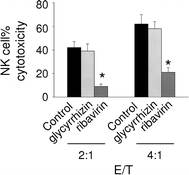Glycyrrhizin inhibits highly pathogenic H5N1 influenza A virus-induced pro-inflammatory cytokine and chemokine expression in human macrophages
- PMID: 20386921
- PMCID: PMC7087222
- DOI: 10.1007/s00430-010-0155-0
Glycyrrhizin inhibits highly pathogenic H5N1 influenza A virus-induced pro-inflammatory cytokine and chemokine expression in human macrophages
Abstract
Hypercytokinaemia is thought to contribute to highly pathogenic H5N1 influenza A virus disease. Glycyrrhizin is known to exert immunomodulatory and anti-inflammatory effects and therefore a candidate drug for the control of H5N1-induced pro-inflammatory gene expression. Here, the effects of an approved parenteral glycyrrhizin preparation were investigated on H5N1 virus replication, H5N1-induced pro-inflammatory responses, and H5N1-induced apoptosis in human monocyte-derived macrophages. Glycyrrhizin 100 μg/ml, a therapeutically achievable concentration, impaired H5N1-induced production of CXCL10, interleukin 6, and CCL5 and inhibited H5N1-induced apoptosis but did not interfere with H5N1 replication. Global inhibition of immune responses may result in the loss of control of virus replication by cytotoxic immune cells including natural killer cells and cytotoxic CD8(+) T-lymphocytes. Notably, glycyrrhizin concentrations that inhibited H5N1-induced pro-inflammatory gene expression did not affect cytolytic activity of natural killer cells. Since H5N1-induced hypercytokinaemia is considered to play an important role within H5N1 pathogenesis, glycyrrhizin may complement the arsenal of potential drugs for the treatment of H5N1 disease.
Figures




Similar articles
-
Glycyrrhizin exerts antioxidative effects in H5N1 influenza A virus-infected cells and inhibits virus replication and pro-inflammatory gene expression.PLoS One. 2011;6(5):e19705. doi: 10.1371/journal.pone.0019705. Epub 2011 May 17. PLoS One. 2011. PMID: 21611183 Free PMC article.
-
N-acetyl-L-cysteine (NAC) inhibits virus replication and expression of pro-inflammatory molecules in A549 cells infected with highly pathogenic H5N1 influenza A virus.Biochem Pharmacol. 2010 Feb 1;79(3):413-20. doi: 10.1016/j.bcp.2009.08.025. Epub 2009 Sep 2. Biochem Pharmacol. 2010. PMID: 19732754
-
H5N1 Influenza a Virus Replicates Productively in Pancreatic Cells and Induces Apoptosis and Pro-Inflammatory Cytokine Response.Front Cell Infect Microbiol. 2018 Nov 6;8:386. doi: 10.3389/fcimb.2018.00386. eCollection 2018. Front Cell Infect Microbiol. 2018. PMID: 30460207 Free PMC article.
-
[Cytokine storm in avian influenza].Mikrobiyol Bul. 2008 Apr;42(2):365-80. Mikrobiyol Bul. 2008. PMID: 18697437 Review. Turkish.
-
Pathogenesis of emerging avian influenza viruses in mammals and the host innate immune response.Immunol Rev. 2008 Oct;225:68-84. doi: 10.1111/j.1600-065X.2008.00690.x. Immunol Rev. 2008. PMID: 18837776 Review.
Cited by
-
Comparisons of the pharmacokinetic profile of four bioactive components after oral administration of gan-sui-ban-xia decoction plus-minus gansui and gancao drug combination in normal rats.Molecules. 2015 May 20;20(5):9295-308. doi: 10.3390/molecules20059295. Molecules. 2015. PMID: 26007184 Free PMC article.
-
Immunomodulatory properties of triterpenes.Phytochem Rev. 2022;21(2):537-563. doi: 10.1007/s11101-021-09785-x. Epub 2021 Nov 18. Phytochem Rev. 2022. PMID: 34812259 Free PMC article. Review.
-
The antiviral and antimicrobial activities of licorice, a widely-used Chinese herb.Acta Pharm Sin B. 2015 Jul;5(4):310-5. doi: 10.1016/j.apsb.2015.05.005. Epub 2015 Jun 17. Acta Pharm Sin B. 2015. PMID: 26579460 Free PMC article. Review.
-
Research Progress on the Antiviral Activity of Glycyrrhizin and its Derivatives in Liquorice.Front Pharmacol. 2021 Jul 6;12:680674. doi: 10.3389/fphar.2021.680674. eCollection 2021. Front Pharmacol. 2021. PMID: 34295250 Free PMC article. Review.
-
Role of Nutraceuticals in COVID-19 Mediated Liver Dysfunction.Molecules. 2020 Dec 13;25(24):5905. doi: 10.3390/molecules25245905. Molecules. 2020. PMID: 33322162 Free PMC article. Review.
References
Publication types
MeSH terms
Substances
LinkOut - more resources
Full Text Sources
Other Literature Sources
Medical
Research Materials

